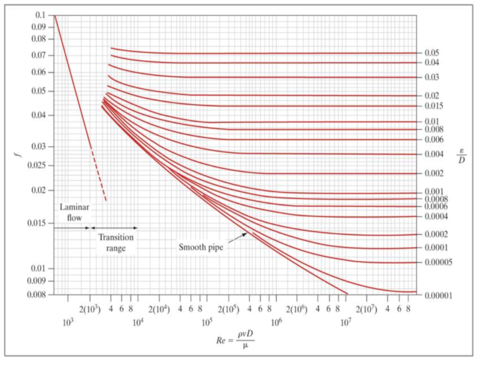
As a reminder, the Reynolds number is discussed in Chapter 9. Dimensionless Number.
When discussing the flow of a fluid through a piping system, we say that friction occurs between the fluid and the pipe wall due to viscous drag. The loss of energy due to the friction against the pipe wall is described by the friction factor. The Darcy friction factor (f) was developed by Henry Darcy (1803–1858), a French scientist who made several important contributions to the field of hydraulics. The friction factor depends on several other factors, including flow regime, Reynolds number, and pipe roughness. The friction factor can be determined in several ways, including from the Moody diagram (show below).
Olive oil having a specific gravity of 0.914 and viscosity of 100.8 centipoise is draining by gravity from the bottom of a tank. The drain line from the tank is a 4-diameter pipe made of commercial steel (pipe roughness, ε=0.045 millimeters). The velocity is 11 meters per second. Determine the friction factor for this system, using the following process.
Step 1: Determine the Reynolds number:
Step 2: Determine flow regime.
- If the flow is laminar (Re £ 2000), continue with step 4.
- If the flow is turbulent or transitional (Re > 2000), continue with step 3.
Step 3: Determine the relative roughness ratio: (ε/D).
Step 4: Determine the Darcy friction factor (f) from the diagram.

Want to see the full answer?
Check out a sample textbook solution
Chapter 13 Solutions
Thinking Like an Engineer: An Active Learning Approach (3rd Edition)
Additional Engineering Textbook Solutions
Applied Fluid Mechanics (7th Edition)
Engineering Mechanics: Statics & Dynamics (14th Edition)
Automotive Technology: Principles, Diagnosis, and Service (5th Edition)
INTERNATIONAL EDITION---Engineering Mechanics: Statics, 14th edition (SI unit)
Engineering Mechanics: Dynamics (14th Edition)
Applied Statics and Strength of Materials (6th Edition)
- The characteristics of a centrifugal pump operating at 1000 rpm is given by H=45-21002. The system characteristics may be represented by H = 28+3200². The units for volume flow rate Q and head H are m³/s and m, respectively. Assume the validity of the pump similarity laws. When one pump operating at 2000 rpm is used, with the system characteristics remaining unchanged, the operating volume flow rate is m³/s.arrow_forwardFluid mechanics Iarrow_forwardHANDWRITTEN AND FINAL ANSWER MUST BE IN ENGLISH UNITS. Show solution. An experimental gas turbine engine is under development to increase its mechanical efficiency. It has a turbine efficiency of 95% and compressor efficiency of 85%. The following parameters are provided: P1 = 550 kPa, T1 = 25 deg C, rp = 5.5, T3 = 1450 deg C, Wnet = 5500 kW. Compute for the (a) flow rate and (b) mean effective pressure. Consider Ethane as your working fluid.arrow_forward
- Two pump impellers with different diameters run at two different speeds under kinematically similar conditions using water. Assume that the pump similarity rules are valid. The first pump impeller has a diameter of 0.1 m, a rotational speed of 1300 rpm and pump head is 6 m. The second pump impeller has a diameter of 0.3 m and a rotational speed of 2400 rpm. The pump head for the second pump impeller is m.arrow_forwardFluid machinery midterm discussionarrow_forwardFluid originally flows through a tube at a rate of 110 cm3 /s. To illustrate the sensitivity of flow rate to various factors, calculate the new flow rate for the following changes with all other factors remaining the same as in the original conditions.Randomized VariablesPx = 2.5ηx = 3.2rx = 0.14lx = 4.6Q = 110 cm3/s Part (a) Calculate the new flow rate in cm3/s if the pressure difference increases by a factor of 2.5 . Part (d) Calculate the new flow rate if another tube is used with a radius 0.14 times the original. Part (e) Calculate the new flow rate if yet another tube is substituted with a radius 0.14 times the original and half the length, and the pressure difference is increased by a factor of 2.5.arrow_forward
- Solve it on priorityarrow_forwardSolve it on priority and correctlyarrow_forwardA pump 254 mm suction pipe and a 127 mm discharge pipe is used to deliver 52 L/s of water. The suction gage reads 15.6 kPa vacuum and the discharge gage located 100 cm above the suction gage which reads reads 108 kPa gage. Determine the following: 1. The total dynamic head in meter 2. The water power in kW 3. The motor horsepower if the pump efficiency is 76% Choices: 1. 13.856 14. 495 14.409 2. 7.631 7.348 8. 245 3. 12.960 14.935 13.935arrow_forward
- A pump 254mm suction pipe and a 127mm discharge pipe is used to deliver 52L/s of water. The suction gage reads 15.6 kPa vacuum and the discharge gage located 100 cm above the suction gage which reads 108 kPa gage. Determine the following: a. the total dynamic head in meters 13.865 14.409 13.415 b. the water power in kW 7.831 7.348 8.245 c. the motor horsepower if the pump efficiency is 66% 15.935 14.924 13.935arrow_forwardthe title of the book: Engineering Thermofluids Thermodynamics, Fluid Mechanics, and Heat Transfer by: Mahmoud Massoudarrow_forwardThe maximum gauge pressure in a hydraulic lift is 15 atm. What is the largest size vehicle (kg.) it can lift if the diameter of the output line is 25 cm? * O 7.6 X 10^3 kg O 6.4 X 10^3 kg O 5.8 X 10°3 kg O 4.7 X 10°3 kg What is the approximate mass of air in a living room 4.8 m long, 3.8 m wide and 280 cm high if the density is 1.3 kg/m? * 43.8 kg 33.7 kg O 27.4 kg O 66.4 kg Calculate the pressure exerted on a floor by a one pointed table leg (170 kg on all four leg) of area = 45 cm2 * O 7.1X 10^3 Pa 9.3 X 10^4 Pa O 3.7 X 10^4 Pa 9.4 X 10^3 Paarrow_forward
 Elements Of ElectromagneticsMechanical EngineeringISBN:9780190698614Author:Sadiku, Matthew N. O.Publisher:Oxford University Press
Elements Of ElectromagneticsMechanical EngineeringISBN:9780190698614Author:Sadiku, Matthew N. O.Publisher:Oxford University Press Mechanics of Materials (10th Edition)Mechanical EngineeringISBN:9780134319650Author:Russell C. HibbelerPublisher:PEARSON
Mechanics of Materials (10th Edition)Mechanical EngineeringISBN:9780134319650Author:Russell C. HibbelerPublisher:PEARSON Thermodynamics: An Engineering ApproachMechanical EngineeringISBN:9781259822674Author:Yunus A. Cengel Dr., Michael A. BolesPublisher:McGraw-Hill Education
Thermodynamics: An Engineering ApproachMechanical EngineeringISBN:9781259822674Author:Yunus A. Cengel Dr., Michael A. BolesPublisher:McGraw-Hill Education Control Systems EngineeringMechanical EngineeringISBN:9781118170519Author:Norman S. NisePublisher:WILEY
Control Systems EngineeringMechanical EngineeringISBN:9781118170519Author:Norman S. NisePublisher:WILEY Mechanics of Materials (MindTap Course List)Mechanical EngineeringISBN:9781337093347Author:Barry J. Goodno, James M. GerePublisher:Cengage Learning
Mechanics of Materials (MindTap Course List)Mechanical EngineeringISBN:9781337093347Author:Barry J. Goodno, James M. GerePublisher:Cengage Learning Engineering Mechanics: StaticsMechanical EngineeringISBN:9781118807330Author:James L. Meriam, L. G. Kraige, J. N. BoltonPublisher:WILEY
Engineering Mechanics: StaticsMechanical EngineeringISBN:9781118807330Author:James L. Meriam, L. G. Kraige, J. N. BoltonPublisher:WILEY





